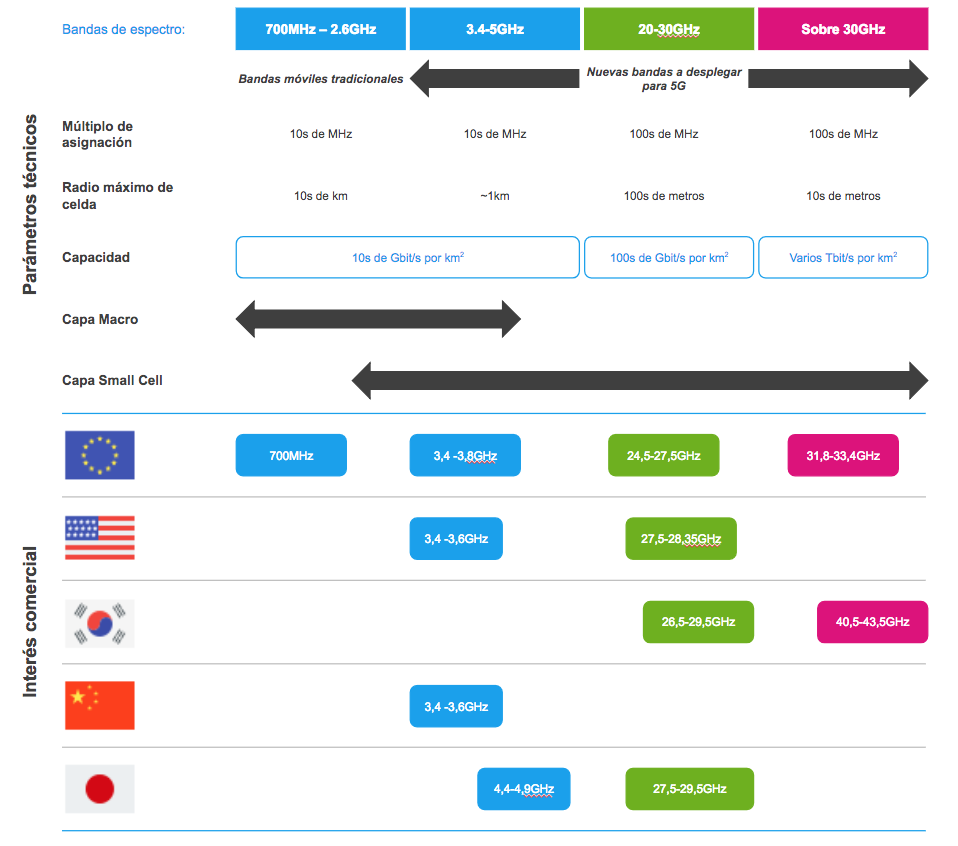Article
Network architecture and spectrum innovations for 5G

5G is expected to require spectrum in low-frequency bands (sub-1 GHz) as well as in high-frequency bands (20-40GHz) that are much higher than existing ones.
After introducing the characteristics of 5G technology, analyzing the strategy of key players and delving into the opportunities for the industry, we close this monograph on 5G technology by addressing network architecture and spectrum.
5G networks will offer architecture innovations because they will require strong infrastructures, including:
Ultra-dense networks / small cells
Given the limited amount of sub-3GHz spectrum that is available, the design of existing 2G, 3G and 4G networks will not be able to handle the services expected for 5G. The high-frequency spectrum lacks the necessary propagation properties needed for 5G to reach its full potential. Therefore, a significant densification of small cells—in other words, bringing the antenna closer to end users by installing equipment in street furniture, businesses and strategic points—will be essential for this new technology. In any case, it should be noted that telecommunications providers in Spain are focusing on macro cells, thereby putting small cells aside for now.
Large-scale transition to fiber
The strong performance offered by 5G from mobile locations to end users must be backed by the telecommunications provider’s core network. This will lead to fiber optic deployment at most mobile locations, although the mmWave spectrum (30-300 GHz) on the E band (70-80 GHz) can also be used to provide ultra-high capacity microwave backhaul.
Cloud RAN
In traditional RANs (Radio Access Network), every base station has its own BBU (Base Band Unit) with a radio that is integrated or located remotely at the top of the tower. There are two potential developments from this point:
– Centralized RAN: Evolved from the established base station (“hotels”) concept, multiple remote radio units (RRUs) are connected to a single BBU and share resources in a flexible manner. The BBU can be local or remote. Its main advantages are cost efficiency and energy efficiency.
– Cloud RAN: China Mobile was a pioneer of this architecture that establishes a functional separation between remote and shared resources. The latter are virtualized and implemented as network functions virtualization (NFV) on a server or the cloud. In addition to offering benefits in terms of cost and energy savings, this option can also support radically new network economies as well as a wide range of services, operating as a precursor of 5G network segmentation.
5G networks will rely to a large degree on emerging technologies such as SDN (Software Defined Networking), NFV (Network Function Virtualization), MEC (Mobile Edge Computing) and FC (Fog Computing).
In telecommunications, a “carrier grade” or “carrier class” refers to an extremely reliable and tested system or hardware/software component. Carrier grade systems, which are tested and designed to meet or exceed “five nines” high-availability standards, provide extremely fast error recovery (usually less than 50 milliseconds).
Meeting user demands in terms of quality services and experiences forces telecommunications providers to deploy new types of carrier grade infrastructures and technologies as well as MIMO antenna systems (capable of emitting in multiple directions at the same time), distributed antenna systems (DAS), small cells and remote radio heads (RRH), among others.
Despite this, most of the traffic load will remain in the hands of macro-cells, so before deploying the new technology infrastructure, telecommunications providers must have a clear strategy for improving their existing transport networks that sustain the macro networks. To do so, they must migrate to an SDN and NFV environment as a measure for reducing the complexities and costs of their transport networks.
The virtualization of network functionality, in combination with the development of software defined networks (SDN), will greatly influence the creation of 5G networks that will enable greater dynamism in how services are managed. The result will be expanded business models and diagrams, present and future.
Issues and potential solution
The cost of the investment needed to deploy 5G is a serious problem in light of the expectations that have been awakened in society.
Telecommunications providers are searching for formulas that will lower this investment as they hope the use cases are able to monetize the technology much more tangibly than 4G and fiber optics.
A potential solution can be found in the example of a Spanish telecommunications provider that has changed the focus on the massive deployment of 5G antennas by using homes as a fundamental element of the mobile network. The vision of this telecommunications provider, which has almost six million fixed broadband customers in Spain (each with a router), is to use their routers as a platform for the mobile network. Many of the issues linked to installing antennas in street furniture are resolved by adding a small radio-electric node with a small antenna (called picocell or femtocell) to the router. If a femtocell is integrated into the router, the customer is the one who supplies the telecommunications provider with a fiber optic connection. The main drawback of this option is the cost of replacing the existing routers with new ones featuring the radio equipment for mobile phone service since they will be more expensive. An existing fiber optic router costs approximately €50, as opposed to a device with a mobile antenna could cost as much as €500, although various experts have noted that this number could be lowered to €200 through industrialized production. In any case, it is not necessary to replace all the existing routers since a possibility would be to only change the devices in those homes and establishments with good coverage along public roadways.
The problem is that 5G requires a very capillary deployment that is both costly and complicated to build and maintain. Additionally, the industry is not able to charge more and it is becoming clear that 4G and fiber optics cannot be monetized as expected . The effort put into those initiatives has already spiked the CAPEX to sales ratio to an unsustainable level. To a large degree, the required investment, combined with stagnated revenue growth, stands in the way of the 5G deployment.
Spectrum
As far as the spectrum, the bands with commercial value and their features are listed below:

As shown in the graph, below 5 GHz there is significant bandwidth available, defined licensing frameworks (in Europe) and a standardized 3GPP with incomplete capacity for 5G.
In spectrum bands within the 20-30GHz range, the focus remains on developing equipment and trials, and it can be seen that the exact band varies by region from 245 GHz to 295 GHz. Bands above 30 GHz are not an initial priority for 3GPP standards. However, the industry has growing interest in future alternatives (e.g.: 405-435 GHz).
5G is expected to require spectrum in low-frequency bands (sub-1 GHz) as well as in high-frequency bands (20-40GHz) that are much higher than existing ones. Although these bands offer faster transmission speeds, they also pose serious issues: short coverage radius and scarce penetration capacity.
In other words, a link above 60 GHz will be effective in an open field or a street but will have a hard time making its way through a building for indoor coverage. This explains the need to use lower frequencies and for the regulator to not rule out 36, 38 or 42 GHz.
As mentioned earlier, we are in the midst of the technology race towards 5G. A few years of intense testing, spectrum auctions, agreements and global standardizations remain, although it is estimated that by 2025, there will be widespread access to the technology that will open the doors to the Internet of Things.
Gregorio Recio
gregorio.recio@nae.es
Gorka Riocerezo
gorka.riocerezo@nae.es

